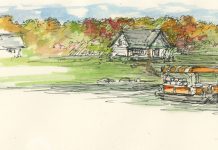When thumbing through seed catalogs, I gazed at the photographs of meadows dotted with daisies, sprinkled with scarlet poppies and crowned with golden coreopsis. I was determined to establish such a sight, and pestered John until he disked up an eighth of an acre for me.
 Back and forth I trudged, leveling the ground with a rake, and tossing seeds. A phoebe called from the nearby peach tree as he watched me. Off to the west, gray clouds hung low over Lake Michigan, and I quickened my step. A spring shower would be the perfect blessing to help the seeds swell and germinate. Despite my efforts, only a few larkspurs towered pink and blue above the quack grass that choked most of the baby plants. Most likely, mice, voles and starlings had eaten the seeds.
Back and forth I trudged, leveling the ground with a rake, and tossing seeds. A phoebe called from the nearby peach tree as he watched me. Off to the west, gray clouds hung low over Lake Michigan, and I quickened my step. A spring shower would be the perfect blessing to help the seeds swell and germinate. Despite my efforts, only a few larkspurs towered pink and blue above the quack grass that choked most of the baby plants. Most likely, mice, voles and starlings had eaten the seeds.
“If you wanted to beat out the weeds, you should have cover-cropped the field with rye and then buckwheat, before planting the flowers,” John said.
“Why didn’t you tell me that last fall?”
“You didn’t ask.”
I tucked my flowery vision into a corner of my mind, and plotted to try again some other time. When Carlos’ bee business expanded to 60 hives, many of our dinner discussions focused on the problem of “nectar valleys,” those times in the growing season when bees have trouble finding an adequate source of nectar. Spring flowers and blooming orchards allowed the bees to fill their supers swiftly in May, but come late June and early July, the nectar supply dropped.
 “We need more flowers,” John said, a rare statement from a man who teases me about encircling my vegetable garden with old roses.
“We need more flowers,” John said, a rare statement from a man who teases me about encircling my vegetable garden with old roses.
“How many flowers?” I asked.
“Acres and acres of flowers,” John answered.
My dream of wild flower fields shimmered once again.
Ever the scientist, John called wild flower seed companies and requested information on which of those seeds were similar in size to clover seed. He chatted with the experts and explained that he wanted to plant a bed of clover beneath the flowers, so all the seeds must roll through his seed drill. Plus, he wanted flowers suited for our climate and soil. Soon, the UPS truck rumbled up our lane and dropped off sacks of daisy, larkspur, bachelor buttons and red poppy seeds.
Earlier that morning Deborah had flung fistfuls of red, green, yellow and blue plastic beads throughout the orchard. The children crept between the trees collecting plastic gems that they strung into necklaces. For years after that party, my sons continued to stumble upon plastic jewels when they played in that location.
In October when the blueberry leaves turned the bog maroon, John planted 30 acres with wildflower and clover seeds. On walks, I taught him how to identify the different seedlings. Lake effect snow finally insulated and protected the baby plants until the Chinooks of spring blew across our farm.
 The orange wallflowers first sprinkled the patchwork of green leaves. Soon daisies sparkled among the blue bachelor buttons, and red poppies shimmered here and there until the fields blazed. Bobolinks took a liking to the sight and nested among the flowers; their bubbling call mingled with the hum of bees. Friends and strangers came to view the spectacle while Carlos stacked supers of honey.
The orange wallflowers first sprinkled the patchwork of green leaves. Soon daisies sparkled among the blue bachelor buttons, and red poppies shimmered here and there until the fields blazed. Bobolinks took a liking to the sight and nested among the flowers; their bubbling call mingled with the hum of bees. Friends and strangers came to view the spectacle while Carlos stacked supers of honey.
Although Carlos no longer keeps bees, the tradition of sowing fields of wildflowers flourishes. Friends photograph brides and grooms or grandchildren standing midst the poppies; visitors gape at the waves of color. Yet, what thrills me most are the rogue flowers planted by birds or jostled out of the seed drill as it bumped from one field to another section of the farm. A single red poppy lights a blueberry row. The sapphire of a bachelor button sparkles at the edge of the asparagus patch.
They remind me of one midsummer party when my friend Deborah told the children that the queen of the fairies had broken her necklace in our cherry orchard. Earlier that morning Deborah had flung fistfuls of red, green, yellow and blue plastic beads throughout the orchard. The children crept between the trees collecting plastic gems that they strung into necklaces. For years after that party, my sons continued to stumble upon plastic jewels when they played in that location.
Like the queen of fairies’ lost treasure, rubies, sapphires and opals now glitter in far corners of our farm. I not only have fields filled with flowers, but hidden jewels waiting to be discovered.
Joan Donaldson writes from her organic blueberry farm near Saugatuck. Her latest novel, “On Viney’s Mountain” won the 2010 Friends of American Writers Award and represented the state of Tennessee at the 2010 National Book Festival. She is a 2017 recipient of a Jane Yolen Mid-list Honor Prize. “Scattered Jewels” was first published by The Christian Science Monitor.







Facebook Comments